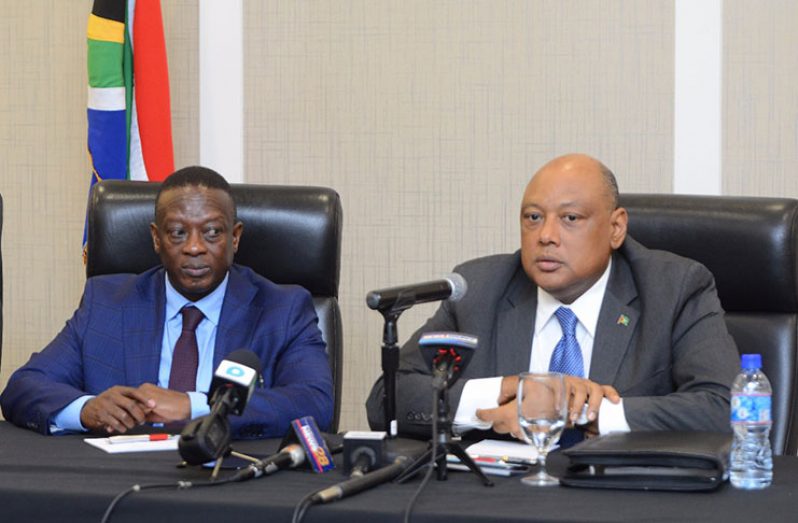SOUTH Africa is more than willing to expose Guyanese artisanal miners to IGoli – a mercury-free technology used to recover gold, Deputy Minister of Mineral Resources of the Republic of South Africa, Godfrey Oliphant, said on Wednesday.
According to MINTEK – South Africa’s National Mineral Research Organisation, IGoli is a simple, safe, and highly effective method of gold extraction that produces an extremely pure product. The process entails leaching the gold concentrate with diluted hydrochloric acid and bleach. Once the solids are filtered, the gold is precipitated out with sodium metabisulphate.
During a joint press conference with Guyana’s Natural Resources Minister Raphael Trotman at the Marriott Hotel, Minister Oliphant said for approximately 20 years, South Africa has moved away from the utilisation of mercury, and now engages in “domestic leaching” in the gold mining sector.
He said IGoli, which was developed by MINTEK to make gold extraction more efficient and environmentally responsible, is very simple and cost effective.
“Actually, it is very cheap,” Minister Oliphant said while emphasising that the chemicals used, such as bleach, does not cause harm to the environment and the human body, as is the case of mercury. According to him, small and medium scale miners can easily adapt to this process and South Africa is committed to sharing it.
“Either we send some of our officials to come and work with miners here to show them how to do this… or we take some of the miners to South Africa,” the deputy minister of mineral resources said. During an engagement with the Guyana Gold and Diamond Miners Association (GGDMA), the Guyana Women Miners Organisation (GWMO) and the National Mining Syndicate prior to the press conference, Minister Oliphant and his South African delegation promoted the use of IGoli.
The mercury-free technology has been demonstrated to small-scale miners in Mozambique, Peru, and to government officials from Tanzania.
“The intellectual property is freely passed on because we feel that the removal of mercury from artisanal mining worldwide is important to the health of our earth,” MINTEK said.
Guyana signed on to the United Nation’s Minamata Convention on Mercury in 2013 and ratified the convention in 2014. Since then it has been taking steps to promote the use of mercury-free technology in the gold mining industry.
Conservation International Guyana (CI-Guyana) is currently collaborating with the Global Environment Facility (GEF) to execute the Eldorado Gold Project – a GYD $1.2B project intended to explore mercury-free mining by 2025, along the supply chain from prospectors to producers. Additionally, the World Wildlife Fund (WWF), with funding from the French Global Environment Facility (FFEM), is working with the Guyana Geology and Mines Commissions (GGMC) to align the Minamata Convention. The GYD$804M (€3.4 million) project will see the demonstration of mercury-free extraction models and sharing of mercury data on a regional level.
DECLARATION OF INTENT
In the case of South Africa, the training of Guyanese miners to carry out the mercury-free IGoli process would likely follow the signing of a Declaration of Intent covering five critical areas – training and capacity building, mining regulations, value added, mapping and surveying, and environmental protection in the mining industry.
Initially, both Minister Trotman and Minister Oliphant had expressed a desire to sign off on a Memorandum of Understanding (MoU) by the end of the five-day visit by the South African Delegation, but on Wednesday, Minister Trotman said a Declaration of Intent would be signed instead at the end of the five-day visit.
“I think that both ministers, as eager as we are, recognise that we do have to have the blessings of our governments collectively. So we have determined that we will sign a Declaration of Intent rather than a MoU, because we would then go to our respective principals for confirmation,” Minister Trotman explained.
That Declaration of Intent is expected to be signed on Friday, the same day that the South African Delegation will meet with the Vice-Chancellor of the University of Guyana, Dr. Ivelaw Griffith, to discuss possible areas of partnership. The minister noted too that the document will also set the foundation for technical officers from the Guyana Geology and Mines Commission (GGMC) and the Guyana Gold Board to be trained on modern technologies of mining employed in South Africa.
“Secondly, we will be looking at ways in which we can strengthen our regulatory framework; what best practices we can import from South Africa into Guyana, and vice versa. Maybe there are a few practices that we have that we can share with South Africa so far as regulation of mining and natural resources are concerned,” Minister Trotman said.
With Guyana exporting the majority of its minerals in their “raw” state, the enhanced partnership between the South American country and South Africa could see a transfer of knowledge, skills and financial resources that would see the former adding value to its commodities on a much larger scale.
“We are producers of gold and diamond but we ship them out to be returned as jewellery to us and undoubtedly, the time has come for us to look further,” Minister Trotman said while admitting that Guyana needs help in building its value-added capabilities.
He noted that in 2018, a South African firm conducted a feasibility study on the establishment of a national gold refinery, but the country has also been receiving offers from other parts of the world.
“We do have a few offers, not just from South Africa but Dubai, India and the US, so it is a step Guyana intends to take so we can do our own gold refining,” Minister Trotman told reporters.
While the Guyana Government, at this stage has not decided on an investor, Minister Trotman said the country can borrow the technologies used in South Africa to refine their minerals – in this case, gold.
Additionally, the Natural Resources Ministry will be turning to the South African Mineral Resources Department for assistance in mapping and surveying the country’s mineral wealth. “We must know exactly what we have, where and in what quantities, and South Africa has shown willingness to assist us there,” the natural resources minister said.
The final area of partnership under the pending Declaration of Intent, which is expected to set the foundation for the MoU, would be environmental protection. Both Minister Trotman and Minister Oliphant have agreed that the environment could be protected through sustainable and environmentally-friendly mining activities.
“Mining is the future and as we improve our technologies, as we talk about the fourth industrial revolution and the ‘green’ economy, it is important that we take all these things into account, especially the human capital in mining as we go forward,” the South African minister said.
Formally, engaged in mining for well over 150 years, South Africa’s mining industry accounts for eight per cent of the country’s Gross Domestic Product (GDP). It has approximately 1,700 mines and quarries producing 53 commodities. Approximately 460,000 people are employed in the mining industry.




.jpg)









